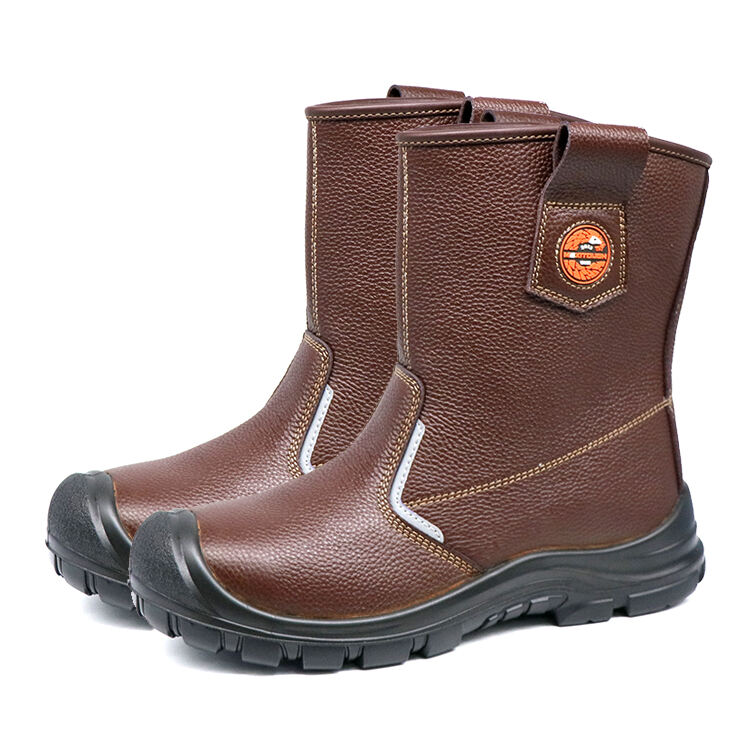
OSHA standards are pivotal in ensuring worker safety, particularly concerning slip prevention, which is essential in workplaces with inherent risks. They enforce regulations that steel toe boots must adhere to, safeguarding the wearer. One such standard is the ASTM F1677, which assesses a boot's slip resistance through specific testing methods. These standards ensure that boots provide adequate traction and minimize slip-and-fall incidents. For instance, industries like construction and manufacturing rely heavily on these standards due to the variety of surfaces and conditions workers encounter daily. Compliance with OSHA standards not only protects workers but also enhances a company's reputation for safety and adherence to guidelines.
Workplaces often present numerous slip hazards, including oily floors, wet surfaces, and uneven terrain, posing significant risks to workers. Slip-resistant outsoles are designed to mitigate these hazards, reducing slip-related injuries. For example, recent statistics suggest that workplaces implementing slip-resistant footwear witness a substantial decrease in slips and fall incidents. Regular assessments are crucial to identifying and addressing slip hazards. Such assessments allow employers to incorporate slip-resistant boots as part of a broader safety strategy, ensuring a safer working environment. By adopting a proactive approach, industries can significantly reduce accident rates and enhance overall workplace safety.
When it comes to steel toe boots, slip-resistant tread patterns are a vital feature. These patterns are specifically engineered to enhance grip and prevent slips in hazardous environments. Designs may include deep grooves or specific angles that channel away liquid and debris, maintaining solid contact with the ground. The materials used in these outsoles, such as rubber or polyurethane, are chosen for their ability to maintain friction in various conditions. Rubber, for instance, offers excellent grip on wet surfaces, while polyurethane excels in oily conditions. A deeper understanding of these features is beneficial for employers and employees in high-risk jobs, like construction or manufacturing, ensuring the safety and productivity of their workforce.
Advancements in lightweight materials have significantly changed the landscape of steel toe boots. Modern designs utilize materials like aluminum and composite to provide robust protection without the added weight. This innovation is crucial in reducing fatigue for workers who wear these boots all day long. There are several lightweight safety toe options available that balance protection with comfort. For instance, composite toes are not only lighter but also don't conduct heat or cold, making them ideal for all-weather wear. The comfort they offer is not just a luxury but a necessity for enhancing workplace productivity. As one expert noted, "Comfort is the cornerstone of safety gear that truly supports the worker's needs."
In wet environments, steel toe boots must be waterproof to ensure both comfort and safety. Waterproofing is achieved through construction features like sealed seams, water-resistant materials, and moisture-wicking linings. These boots maintain traction and prevent slippage, even when the ground is slick with water or other liquids. Statistics indicate that slips are common in wet conditions, underscoring the importance of waterproof steel toe boots. Industries such as mining, forestry, and certain outdoor construction sites see significant benefits from these features, ensuring worker safety and compliance with safety standards. Waterproof designs not only keep feet dry but also enhance overall stability, contributing to a safer work environment.
Slip-resistant steel toe safety shoes offer dual protection by combining impact resistance with traction control, significantly enhancing employee safety. These shoes are designed to protect the feet from heavy objects and dangerous environments while maintaining a firm grip on various surfaces. Studies have shown that impact-resistant work boots can reduce injury rates, providing a safer workplace. According to statistics, companies investing in high-quality slip-resistant safety shoes can experience substantial cost savings. This is achieved by reducing workplace accidents and, consequently, insurance-related expenses and productivity losses.
Ergonomic design features in slip-resistant steel toe boots are critical for reducing foot fatigue, thus enhancing employee comfort. These boots often include cushioned insoles and arch support that distribute weight evenly and reduce strain on the feet during extended wear. Studies indicate a direct link between footwear comfort and workplace productivity. Employees in comfortable safety footwear report higher productivity levels compared to those wearing traditional options. Training programs are vital for educating workers about selecting appropriate footwear, ensuring they receive maximum safety and comfort. Understanding these elements is essential for improving overall job performance and employee well-being.
Understanding the unique traction requirements for different job environments is crucial when selecting men's steel toe work boots. Each work setting presents distinctive challenges that necessitate specific traction features to prevent slips and falls. For instance, construction sites often require boots with deep treads for mud and uneven surfaces, while factory floors might benefit from smoother soles that handle oil and water spills effectively. Employers play a pivotal role in assessing these needs and must communicate job-specific traction parameters to ensure that their workers are adequately equipped for their safety. By doing so, not only do they enhance safety, but they also align with occupational health standards.
Ensuring the proper fit of steel toe work boots is essential for achieving optimal safety compliance. A well-fitted boot not only offers comfort but also maximizes the protective capabilities of the footwear, effectively safeguarding workers against potential hazards. Common fit testing methods involve checking for ample toe room and a snug fit around the heels and ankles, as recommended by the Canadian Centre for Occupational Health and Safety. This practice ensures adherence to OSHA guidelines and enhances wearer comfort. Employers should provide guidance on fit testing and encourage periodic assessments to confirm that the boots remain aligned with safety compliance and user needs.
Copyright © 2024©Shandong Max Gloves Sales Co., Ltd.——Privacy Policy